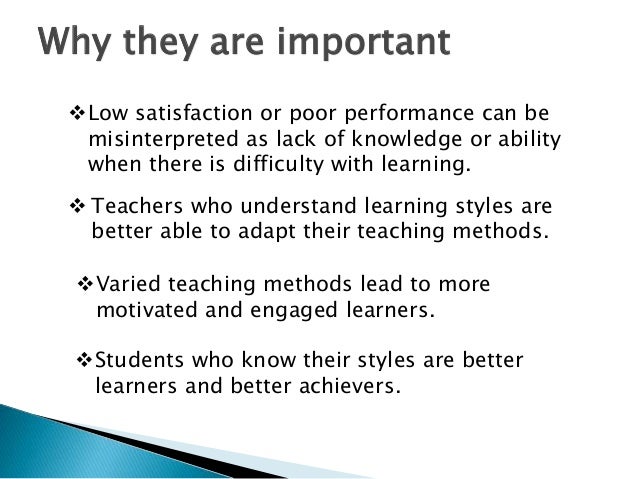

Pashler, H., McDaniel, M., Rohrer, D., & Bjork, R. Academy of management learning & education, 4(2), 193-212. Learning styles and learning spaces: Enhancing experiential learning in higher education. Do learners really know best? Urban legends in education. Learning styles: An overview of theories, models, and measures. The four sensory modalities in Fleming’s VARK model are:Ĭassidy, S. One of the popular ways to find a preferred learning style is to use a questionnaire, such as Honey and Mumford (2006).Īdapted from Kolb’s experiential learning model, below are the learning styles classifications from Honey and Mumford.
Kinesthetic learners who learn by doing and hands on tasks- Do It. Auditory learners who learn best through the process of listening and talking- Hear It. Visual learners who prefer images, pictures, diagrams, videos and demonstrations- See It. Kolb and Kolb (2005) provide a discussion on the learning process in higher education and the concepts of learning styles and learning cycle.ĭifferent students have different modes of learning, and so to improve their learning could be matching one’s teaching with that to the preferred learning mode. Kolb (2007) describes learning as an experiential learning concept forming concrete and abstract conceptualisations. Maybe we move around the styles depending on the topic being learnt or maybe it’s all an educational myth and we need to move onto other evidence based learning theories (see reference list for more discussion on the evidence base for learning styles). While our program is effective for all learning styles, it is specifically designed to meet the unique needs of haptic learners that are seldom addressed in a traditional school environment. Learner related performance may be dependent on the subject, motivation, learning space and personality of the learner. Learning styles can be organized into three broad categories: auditory, visual, and haptic. The overall aim for education is to tailor teaching style to improve learning. They may well be correct, but you can decide for yourself if learning styles exist and are appropriate to form part of your teaching strategy. Although the auditory learner does have the potential to understand the material better, there are cases where the best resources aren't being used for this to occur.Let’s get straight into the discussion first, as I predict many nurse educators will be reading this topic and wanting to say ‘what a waste of time’ as learning styles don’t exist. Every now and then, there may be an audio or video (visual & auditory) that will help the auditory learner, however this is uncommonly the case.  The majority of formal post-secondary education uses readings and articles to deliver the content. Because other noises are present, there will be a continual change in such noises which may prove to be detrimentally distracting for the auditory learner.
The majority of formal post-secondary education uses readings and articles to deliver the content. Because other noises are present, there will be a continual change in such noises which may prove to be detrimentally distracting for the auditory learner.  For example, a cafe would not be an effective location for an auditory learner to study.
For example, a cafe would not be an effective location for an auditory learner to study. 
Because of this, auditory learners may find it difficult to study in an auditory fashion with their peers. Visual learners prefer to use pictures, graphs and images to organize and communicate their thoughts and learn best from using flash cards.
The majority of students prefer to be isolated in a quiet location that allows them to go through a large amount of material in a shorter period of time, in comparison to using auditory learning strategies.








 0 kommentar(er)
0 kommentar(er)
